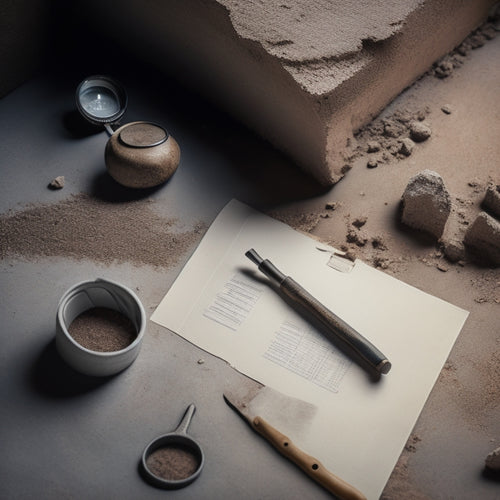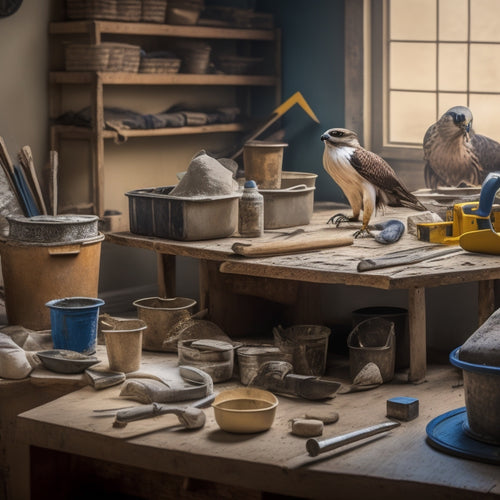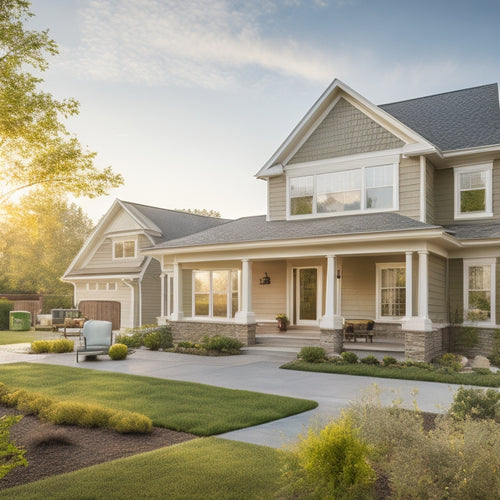
Why Fix Cracks First in Home Renovation
Share
When tackling a home renovation, it's crucial to fix cracks first. Failing to address these issues can lead to costly future repairs, water damage, and even structural weakness. By prioritizing crack repairs, you'll prevent further damage, guarantee safety, and maintain your home's value. Start by evaluating damage, identifying the source of cracks and leaks, and addressing structural integrity. From there, you can focus on moisture damage prevention, aesthetic appeal, and safety improvements. By fixing cracks first, you'll be well on your way to a successful renovation - and discovering the importance of this critical step is just the beginning of your journey.
Key Takeaways
• Fixing cracks first in home renovation prevents water damage, structural weakness, and mold growth, reducing costly future repairs.
• Addressing cracks early maintains structural integrity, ensuring safety and protecting occupants from risks.
• Proactively fixing cracks prevents further damage, reduces repair timelines, and saves on renovation costs.
• Filling cracks and gaps restores aesthetic appeal, increases resale value, and creates a uniform surface.
• Prioritizing crack repairs allows for a more efficient renovation process, enabling a smoother and more successful project outcome.
Assess Damage and Prioritize Repairs
Before tackling the renovation, take a thorough walk-through to identify all cracks in the walls, ceilings, and floors, and prioritize repairs based on their severity and potential impact on the structural integrity of your home.
This damage assessment is vital in determining which cracks need immediate attention and which can be addressed later. Make a list of all the cracks you've found, noting their location, size, and severity. Then, categorize them into must-fix, should-fix, and nice-to-fix groups.
Based on your assessment, create a repair timeline that outlines the order and pace of the repairs. Focus on addressing the most critical cracks first, such as those that compromise the structure or pose a safety risk.
Next, tackle cracks that can cause significant damage if left unrepaired, like those near water sources or in load-bearing areas. Finally, address cosmetic cracks that affect the appearance of your home.
Identify Source of Cracks and Leaks
When identifying the source of cracks and leaks, you'll need to conduct a thorough inspection of your home's exterior and interior.
You'll want to start by examining the walls and ceilings for any signs of water damage or structural weaknesses.
Next, you'll move on to checking windows and doors, as well as the foundation and roof, to pinpoint the root cause of the issue.
Inspect Walls and Ceilings
Examine walls and ceilings methodically to identify signs of cracks, water stains, or discoloration, which can indicate underlying structural issues or water damage.
As you inspect, look for different crack types, such as hairline cracks, spider cracks, or larger fissures. Note the location, size, and direction of each crack, as this can help determine the cause. Use various inspection techniques, including visual examination, tapping, and probing, to assess the severity of the damage.
When inspecting walls, pay attention to areas around windows, doors, and corners, where cracks are more likely to occur.
Check for signs of water damage, such as peeling paint, warped drywall, or rust stains.
On ceilings, look for water stains, sagging, or unevenness, which can indicate leaks or structural weaknesses.
Check Windows and Doors
Check windows and doors for signs of wear, damage, or improper installation that could be causing cracks and leaks in surrounding walls and ceilings. You'll want to inspect these areas carefully, as they can be a common source of issues.
Here are a few things to look for:
-
Window frame damage: Check for signs of rot, warping, or cracks in the window frames, as these can allow water to seep in and cause damage to surrounding walls and ceilings.
-
Door seal failures: Inspect the door seals for signs of wear or damage, as a faulty seal can let air and water into your home, causing cracks and leaks.
-
Improper installation: Verify that windows and doors were installed correctly, as improper installation can lead to a range of issues, including cracks and leaks.
Examine Foundation and Roof
Inspecting your home's foundation and roof is vital for identifying the source of cracks and leaks, as these structural components are prone to damage from water, soil settlement, and weathering.
You'll want to examine the foundation for signs of instability, such as cracks in walls, uneven floors, or door and window frames that are no longer square. Verify the foundation stability by checking for water damage, soil erosion, or termite infestation.
Next, inspect your roof for signs of wear and tear, such as missing or damaged shingles, curled or buckled shingles, or signs of animal infestation. Roof durability is important, as a compromised roof can lead to water damage and further structural issues.
Check for gaps in flashing, chimneys, and vents, and inspect the condition of gutters and downspouts. By examining these significant areas, you'll be able to identify the root cause of cracks and leaks, allowing you to address the issue effectively and prevent further damage.
Prevent Costly Future Repairs
When you're fixing cracks in your home renovation, you're not just repairing cosmetic issues - you're also preventing costly future repairs.
By addressing cracks proactively, you'll stop water damage from spreading and reduce the risk of structural weakness.
Now, let's explore the key strategies for preventing these costly issues, starting with stopping water damage spread and reducing structural weakness risk.
Stop Water Damage Spread
You must identify and address the source of water intrusion immediately to prevent further damage and costly future repairs.
Water damage can spread quickly, causing extensive harm to your home's structure and your wallet. To stop water damage spread, you need to take swift action.
Here are 3 essential steps to take:
-
Locate and fix the source: Identify where the water is coming from and repair or replace the faulty component, whether it's a leaky pipe, damaged roof, or cracked wall.
-
Dry the area: Use fans and dehumidifiers to dry the affected area completely, preventing further water damage and potential mold growth.
-
Apply waterproofing techniques: Implement long-term maintenance strategies, such as applying waterproof coatings or sealants, to prevent future water intrusion.
Reduce Structural Weakness Risk
By addressing cracks and weaknesses in your home's structure, you can greatly reduce the risk of costly future repairs and guarantee your home remains safe and secure for years to come.
A thorough structural assessment is essential to identify potential vulnerabilities and prioritize repairs. By doing so, you'll prevent minor issues from escalating into major problems that can compromise your home's integrity.
When it comes to repair prioritization, it's vital to focus on the most critical areas first. This means tackling cracks in load-bearing walls, foundations, and beams, as these can have the greatest impact on your home's overall structure.
Don't overlook cracks in exterior walls, windows, and doors, as these can allow water to seep in and cause further damage.
Ensure Structural Integrity Remains
Cracks in walls, ceilings, or foundations can compromise the load-bearing capacity of your home, making it vital to assess and address these issues promptly to maintain structural integrity.
As a homeowner, you must prioritize structural assessment to identify potential weaknesses and create a repair timeline that guarantees your home remains safe and secure.
Here are three key reasons why you should prioritize structural integrity:
-
Prevent Further Damage: Unaddressed cracks can lead to more extensive and costly repairs down the line. By fixing cracks promptly, you prevent further damage and minimize the risk of structural weaknesses.
-
Guarantee Safety: Cracks can compromise the stability of your home, putting you and your loved ones at risk. By maintaining structural integrity, you create a safe living environment.
-
Protect Your Investment: Your home is a significant investment, and neglecting structural issues can lead to decreased property value. By prioritizing structural integrity, you protect your investment and maintain its value.
Moisture Damage and Mold Prevention
Moisture damage and mold growth can silently wreak havoc on your home's structure, compromising its integrity and posing considerable health risks if left unchecked.
As a homeowner, it's essential you address any cracks or gaps in your walls, floors, or ceilings to prevent moisture from seeping in. When water enters your home, it creates an ideal environment for mold growth, which can lead to respiratory issues, allergic reactions, and even long-term health problems.
To combat moisture damage and mold growth, you should install moisture barriers in areas prone to dampness, such as basements or crawl spaces. These barriers act as a shield, preventing water from penetrating the walls and floors.
Additionally, guarantee proper ventilation in your home, especially in areas with high humidity like bathrooms and kitchens. By taking these proactive measures, you'll greatly reduce the risk of moisture damage and mold growth, protecting your home's structure and your family's health.
Improve Aesthetic Appeal and Value
Filling cracks and gaps in your home's surfaces not only restores its structural integrity but also enhances its visual appeal, boosting its resale value and making it a more enjoyable living space.
By addressing these imperfections, you can greatly improve your home's curb appeal, making it more attractive to potential buyers if you ever decide to sell. A well-maintained exterior can also increase your property valuation, providing a strong return on investment.
Here are three ways filling cracks can improve your home's aesthetic appeal:
-
Uniform appearance: Filled cracks and gaps create a uniform surface, eliminating unsightly blemishes that can detract from your home's beauty.
-
Enhanced color: By filling cracks, you can restore the original color and finish of your home's surfaces, making them look like new again.
-
Improved natural light: By sealing gaps around windows and doors, you can reduce the amount of dust and debris that enters your home, allowing more natural light to shine through and brighten up your living space.
Enhance Safety and Accessibility
By addressing cracks and gaps, you can prevent tripping hazards and slippery surfaces, creating a safer environment for everyone in your home. This is especially vital for households with elderly or young family members who may be more prone to accidents. By fixing cracks, you're not only ensuring compliance with safety standards, but also promoting a sense of security and well-being.
Moreover, addressing cracks and gaps can greatly enhance accessibility features in your home. For instance, smoothing out uneven surfaces can facilitate easier movement for people with mobility impairments.
Additionally, filling in gaps around doors and windows can reduce the risk of falls and injuries. By prioritizing crack repair, you're creating a more inclusive and accessible living space that caters to the needs of all family members.
This attention to detail won't only improve safety but also foster a sense of belonging and independence for everyone in your household.
Prepare for Successful Renovations
Before diving into your home renovation project, you'll want to identify and address any underlying issues that could sabotage your efforts, such as hidden structural damage or outdated electrical systems, to confirm a successful and stress-free renovation. This preparation phase is vital to guarantee that your project stays on track and within budget.
To prepare for successful renovations, consider the following:
-
Budget planning: Establish a realistic budget and contingency fund to account for unexpected expenses. This will help you make informed decisions about material selection and labor costs.
-
Material selection: Research and select materials that meet your needs, budget, and personal preferences. Consider factors such as durability, sustainability, and maintenance requirements.
-
Project scope: Clearly define the scope of your project to avoid scope creep and costly changes down the line. Identify must-haves, nice-to-haves, and areas where you can compromise.
Create a Solid Foundation First
Cracking open walls and ceilings often reveals hidden structural damage, rotting wood, or outdated materials that must be addressed to create a solid foundation for your renovation. You can't just slap on a fresh coat of paint or new flooring without guaranteeing the underlying structure is sound. It's essential to identify and fix any underlying issues to prevent future cracks and damage.
| Foundation Issue | Consequence | Solution |
|---|---|---|
| Weak or rotten wood | Structural instability | Replace with new, treated wood |
| Water damage | Mold growth, further damage | Dry and repair affected area |
| Poor insulation | Energy inefficiency, moisture accumulation | Add insulation, guarantee proper ventilation |
Frequently Asked Questions
Can I Fix Cracks Myself or Do I Need a Professional?
You're wondering if you can tackle those cracks on your own or if it's time to call in a pro.
While DIY techniques can be tempting, it's important to assess the severity of the cracks first.
If they're shallow and cosmetic, you might be able to handle them yourself.
However, if they're deep or widespread, a professional assessment is vital to identify underlying issues and guarantee a proper fix that lasts.
How Long Does It Take to Fix Cracks in Walls and Ceilings?
Like a puzzle, you're piecing together the timeline for your home renovation.
Now, you're wondering how long it takes to fix those pesky cracks in your walls and ceilings.
The answer depends on the type of crack and repair method.
Hairline cracks might take a few hours to fix, while deeper cracks or those requiring epoxy injection can take several days.
Don't worry, you'll be back to smooth walls and ceilings in no time, and you'll be one step closer to your dream home.
Are All Cracks a Sign of Serious Structural Damage?
You're right to wonder if all cracks signal serious structural damage. The truth is, not all cracks are created equal.
A thorough crack assessment is necessary to determine the severity of the issue. During this process, a professional evaluates the crack's size, location, and pattern to identify potential threats to your home's structural integrity.
Will Fixing Cracks Increase the Value of My Home?
When you're thinking of selling, you wonder: will fixing cracks increase the value of your home? The answer is yes.
A thorough crack assessment before listing can lead to a higher home appraisal. By addressing those unsightly cracks, you're showing potential buyers that you've taken care of the property.
This attention to detail can boost your home's value and appeal, making it more attractive to buyers and setting you apart from the competition.
Can I Fix Cracks With Just Paint or Do I Need More?
You're wondering if a fresh coat of paint will magically erase those pesky cracks, but unfortunately, that's just a Band-Aid on a broken bone.
To truly fix cracks, you need to address the underlying causes, like settlement or water damage.
An effective repair involves identifying the root issue, then filling and sealing the crack with a suitable material.
Don't just cover it up, fix it for good!
Conclusion
You've finally decided to tackle that home renovation project, but you're wondering if fixing cracks first is really necessary.
Yes, it is! By addressing cracks and leaks, you'll prevent costly future repairs, guarantee structural integrity, and prevent moisture damage and mold growth.
Think it's too expensive or time-consuming? Consider this: neglecting cracks can lead to catastrophic failures, costing you even more in the long run.
Fixing cracks first is an essential step in creating a solid foundation for your renovation.
Related Posts
-

Crack Repair Inspection Checklist for Home Renovation
When creating a crack repair inspection checklist for your home renovation project, you'll want to identify crack typ...
-

Affordable Plastering Tools for Home Renovation Success
You're taking the first step towards a successful home renovation by investing in the right plastering tools. Start w...
-

Streamline Your Exterior Renovation Timeline
To streamline your exterior renovation timeline, you'll need to approach the process strategically. Start by planning...


